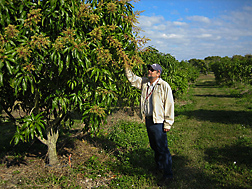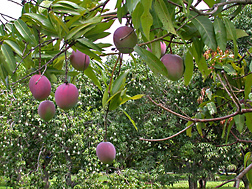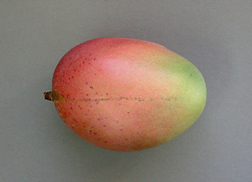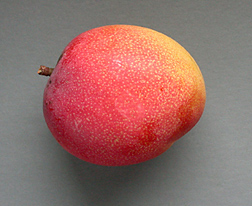Tracing Florida Mangoes’ Family Tree
|
|
A highly esteemed traditional crop in India and Southeast Asia for centuries, mangoes have also become well established in tropical regions of Central and South America over the past 500 years. In the United States, mangoes are grown in Florida and Hawaii, as well as in Puerto Rico.
Introduction of mangoes into Florida and later development of a unique Florida group of mangoes have been thoroughly reviewed by ARS Subtropical Horticulture Research Station (SHRS) geneticist Ray Schnell in Miami over the past dozen years. In 1980, SHRS was formally named a clonal repository within the National Plant Germplasm System (NPGS) with primary responsibility for collecting and preserving mango and other subtropical crop species.
Mangoes belong to the genus Mangifera, which comprises about 30 species of tropical fruiting trees in the flowering plant family Anacardiaceae. The mango tree is referred to as Mangifera indica. While earliest plantings of mango germplasm at SHRS occurred in the 1920s, the first mango introductions to Florida date back to around 1880.
Historically, mango has been highly revered in southern Asia, and it’s been referred to as “the king of fruits.” Among Hindus, its leaves are ritually used for floral decorations in religious ceremonies and marriages. Today it is cultivated in tropical and warmer subtropical climates in Asia, Africa, Australia, and the Americas. With more than 1,000 known cultivars, it’s been said to be the most commonly eaten fresh fruit worldwide. Ripe mango is best known for its very sweet and unique taste, and its high water content makes it refreshing to eat.
|
|
One Shoot or Two?
Mango cultivars are classified based on the type of embryo that develops from the seed. Monoembryonic cultivars produce a single shoot, while polyembryonic types germinate multiple shoots. The early mango introductions to Florida were mostly from the West Indies and India. Cultivars from the West Indies flowered and set fruit well under Florida conditions but had a poor flavor. For instance, one of the most widely grown early West Indies introductions was nicknamed “Turpentine” because of its flavor; there are trace amounts of turpentine found in some rare varieties.
On the other hand, the early Indian mango cultivars were fine-flavored, but they flowered and set fruit poorly under south Florida conditions. So, through hybridization, cultivars were developed that embody desirable traits of Indian cultivars (mainly monoembryonic) and of Southeast Asian cultivars (mainly polyembryonic) and are suitable for production under Florida’s subtropical conditions.
|
|
Charting Mangoes’ Diversity
To efficiently develop improved mango cultivars, it is first important to understand genetic relationships among current Florida cultivars as well as their relationships to both Indian and Southeast Asian races. Schnell has been working with SHRS colleagues—geneticists Steve Brown, Cecile Olano, David Kuhn, and Alan Meerow—to use microsatellite markers to evaluate the genetic diversity in the large collections of mangoes maintained at SHRS and at the Fairchild Tropical Botanic Garden, also in Miami. This will help identify the genes involved in mangoes’ wide adaptation.
Leaf material used in this study, maintained at the SHRS germplasm repository, was broadly categorized into groups by geographic origin: Florida, India, Hawaii, Central America, South America, Africa, Israel, and the Pacific. Plants originating from Cuba, Puerto Rico, Haiti, Jamaica, Trinidad, and the West Indies were considered West Indian. The Southeast Asian group included plant material from Borneo, Burma, Indonesia, Philippines, Vietnam, Australia, Cambodia, Laos, and Thailand.
Closer to India
DNA extraction and analysis performed on the leaf tissue led to findings suggesting that Florida mango cultivar types are more closely related to Indian types than to Southeast Asian types. Interestingly, the Florida types were not found to be genetically more diverse than either of the originating parental groups.
But the Florida mangoes are unique, and a subset of them has proven to have an unusually high level of production stability and environmental adaptability. Among these productive, adaptable mangoes are Keitt, Tommy Atkins, Haden, Parvin, and Irwin, all of which produce dependably over a range of environmental conditions.
There was a marked difference that clearly separated M. indica populations—so much so that it separated Southeast Asian cultivars from all others. There was a close relationship between the Florida, Hawaii, and Israeli clusters—which was anticipated by the SHRS scientists, because much germplasm has been exchanged between plant breeders in the three areas.
“Understanding this valuable genetic architecture—how it arose, its mode of inheritance, and which mangoes have the highest rate of production and adaptability—will be of the utmost importance,” said Schnell. “It’ll be important both for future mango breeding efforts and for commercial production of mango, not only in Florida, but anywhere in the world with a similar climate.”—By Alfredo Flores, Agricultural Research Service Information Staff.
This research is part of Plant Genetic Resources, Genomics, and Genetic Improvement, an ARS national program (#301) described on the World Wide Web at www.nps.ars.usda.gov.
Raymond J. Schnell is with the USDA-ARS Subtropical Horticulture Research Station, 13601 Old Cutler Rd., Miami, FL 33158; phone (786) 573-7074, fax (305) 969-6410.
"Tracing Florida Mangoes’ Family Tree" was published in the April 2008 issue of Agricultural Research magazine.










